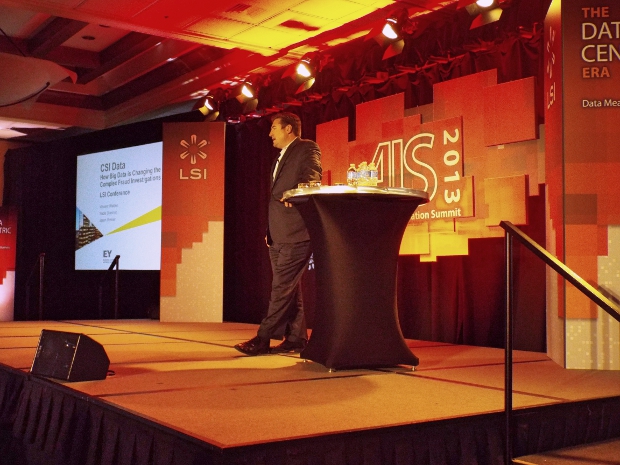LSI’s AIS 2013 continued with its fourth keynote presentation. Vince M. Walden, a partner in Ernst & Young’s Fraud Investigation and Dispute Services division, spoke on the topic of “CSI Data — How Big Data is Changing The Face of Complex Fraud Investigations.”
Joining Vince Walden on the stage were Nadia Brannon, an Ernst & Young executive director in Vince’s fraud division, and Jason Brenier, who is E & Y’s head computer forensic scientist.
With new technologies in hardware and software comes the ability to analyze huge data sets to discover patterns or key identifiers that may indicate either fraud or noncompliance with regulatory agency rules.
As a global company, E & Y does business in virtually every corner of the globe, so not only is it critical to analyze terabytes of data, but to also be able to do it in dozens of languages across multiple different accounting systems.
The ability to process terabytes of data from multiple sources in minutes (in some cases mere seconds) as opposed to hours and days and worse allows auditors and/or investigators to ask questions they could never have asked before. Combining the results of analysis of divergent data sets computationally as opposed to manually comparing results creates the ability to very quickly identify a pool of suspicious factors that have a common source, thus quickly pointing to where further investigation is warranted.
As part of a major investigation of a global financial services company’s sudden bankruptcy, E & Y was asked to get involved. The “big data” challenge that this presented to auditors and/or investigators was to deploy a cost-effective approach to be able to analyze e-mail communications and trade data from multiple systems to trace missing funds from customer accounts, and to be able to report results to investigators in a timely manner.
Starting with over 30TB of forensically collected data held by over 500 custodians, they needed to analyze data from over 1000 unique trading and accounting systems. All of that was narrowed down to 3TB of data with results indicating that further investigation was required. This massive undertaking, by utilizing big data analytics capabilities processed by next-gen computational abilities, allowed E & Y to identify relevant information that is assisting multiple litigation parties and multiple regulatory investigations.
As big data computational capabilities continue to evolve, when it comes to audits and investigations, maybe that needle in that haystack is not so safe anymore.
 The SSD Review The Worlds Dedicated SSD Education and Review Resource |
The SSD Review The Worlds Dedicated SSD Education and Review Resource | 

